




Stereochemistry: A Brief Description
Stereochemistry is concerned with the depiction of molecules in three dimensions. In biological systems, this has broader implications. One stereoisomer of a molecule, for instance, makes up a majority of medications. One stereoisomer may have beneficial effects on the body while the other may not, or even be poisonous.
Stereochemistry, sometimes known as the "chemistry of space," is the study of how atoms and groups are arranged spatially within molecules. Stereochemistry primarily concentrates on stereoisomers. This area of chemistry is frequently referred to as 3-D chemistry. “The isomerism that is generated by the non-similar configurations of atoms or functional groups bonded to an atom in space" is known as stereoisomerism.
Types of Representations of Molecules in 3d
Different types of representations can be used to depict the three-dimensional (3-D) structure of organic molecules on paper. There are mainly four types of representations of organic molecules in three dimensions:
Wedge Dash
Fischer Projection
Sawhorse
Newman Projection
Wedge Dash Representation
A Wedge Dash, the most popular three-dimensional depiction of a molecule on a two-dimensional surface is in projection (paper). This type of representation is typically used for molecules with chiral centres. This type of representation employs three different types of lines.
Solid wedges or thick lines signify bond projections towards the observer or above the paper's surface. A continuous or regular line denotes a bond in the plane of the paper. A bond projection away from the observer is indicated by a dashed or broken line.
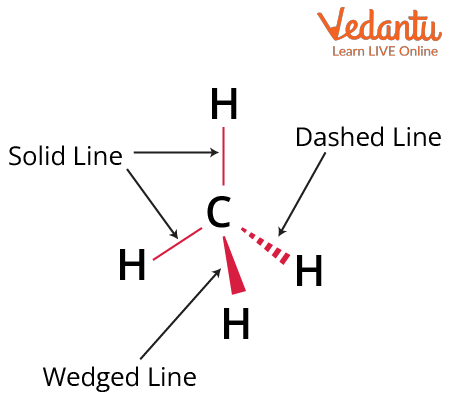
Wedge dash representation
Fischer Projection
The compound's carbon chain is projected vertically, with the topmost carbon being the one that is the most oxidised (as defined by the nomenclature rule). The chiral carbon atom is typically deleted because it is in the plane of the paper. The intersection of asymmetric carbon is represented by cross lines. The chiral carbon's horizontal bonds are thought to be above the plane of a piece of paper or point at the observer. The chiral carbon's vertical linkages are thought to be below the plane of paper or away from the observer.
(Image will be uploaded soon)
Keeping the preceding points in mind can assist the observer in converting the wedge dash structure to the Fischer projection and determining the similarity between the Fischer and the wedge dash.
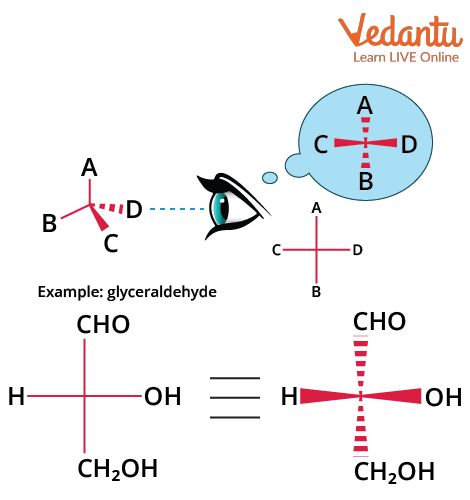
Wedge dash to Fischer
Sawhorse
The sawhorse formula describes how all the atoms or groups are arranged on two nearby carbon atoms. For the sake of clarity, the bonds connecting the two carbon atoms are depicted diagonally and as being substantially longer. It is assumed that the carbon in the lower left hand and the upper right hand carbon is the back carbon and the front carbon towards the observer or toward the observer's side, respectively, like ethane. In the Sawhorse formula, all parallel bonds are eclipsed while all antiparallel bonds are staggered. Bulky groups are closer to one another at 600 angles in a gauche representation.
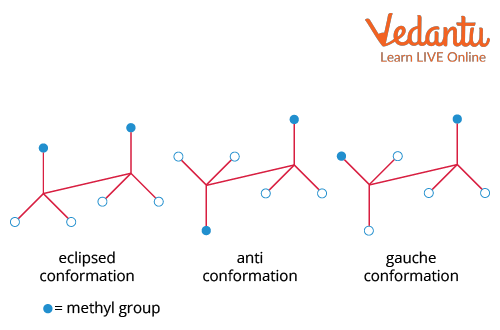
Sawhorse representation
Newman Projection
The Newman projection, which was invented by Newman, is a very straightforward technique for displaying three-dimensional Mathematics on two-dimensional paper. The molecule is viewed from the front or along the axis of a carbon-carbon bond in these calculations. A point denotes the carbon atom closest to the eye, and a circle denotes the carbon atom farther away. A dot or circle is used to represent the bond between the three atoms or groups on the carbon atoms at 1200 degree angle to one another. All parallel bonds are eclipsed and antiparallel or opposite bonds in the Newman projection are staggered.
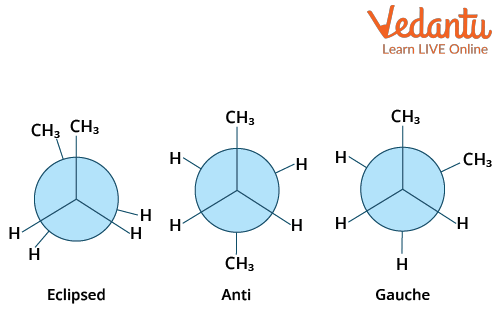
Newman projection
Wedge Dash to Newman Projection
The image shows that the front carbon is represented by a dot in the Newman projection. By aligning the eye and specifying the view, one can easily convert wedge dash into Newman projection.
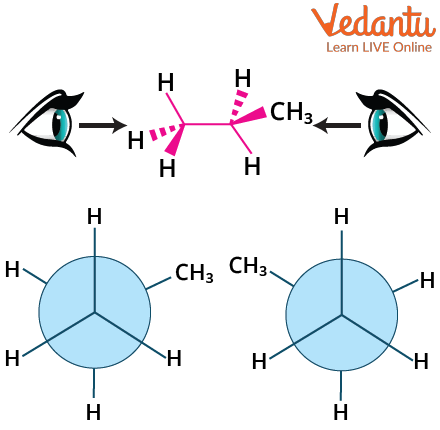
Wedge dash to Newman projection
R S Configuration in Wedge Dash
Assigning Priority
The priority is determined by the atomic number of each of the four atoms directly connected to the chiral carbon in the event that they are all different. Priority is given to the atom with the highest atomic number. If there are two or more isotopes of the same element, the isotope with the higher mass is given priority.
The following atom's atomic number is utilised to determine priority if two or more of the atoms directly bound to the chiral carbon are identical. Priority is established at the first point of difference along the chain if these atoms likewise have identical atoms linked to them. If a double or triple bond is coupled to the chiral centre, the implicated electrons are duplicated or triplicated correspondingly. Hence, the first step is to assign priority to the group.
When the priority order (1 →2→ 3) is clockwise, and the group with the lowest priority is away from the observer (i.e., connected by a dashed line), the arrangement is designated as R. The configuration is S if the priority order is anticlockwise.

R configuration
The picture shows R configuration as H is away from the observer and 1 →2→ 3 is clockwise.
Exchange two groups so that a dashed line joins the group with the lowest priority if the group with the lowest priority is not away from the observer. As you can see, the configuration is designated as S if the sequence is clockwise and R if it is anticlockwise. This is because you have switched two groups and are now figuring out the original molecule's enantiomer's conformational.
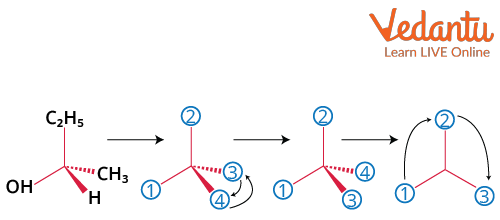
Finding RS configuration
In the above image, the first structure has an S configuration due to an anticlockwise arrangement of groups according to priority. However, in the third structure when two groups are interchanged, the configuration changes from S to R.
Conclusion
Stereochemistry is concerned with the depiction of molecules in three dimensions. In biological systems, this has broader implications. Different representations can be used to depict the three-dimensional (3-D) structure of organic molecules on paper. There are mainly four types of representations of organic molecules in three dimensions: Fischer Projection, Sawhorse, Newman Projection, and Wedge Dash. We discussed what each conversion looks like. We have also seen how to convert wedge dash to Fischer and Fischer projection to wedge dash. Assigning priority is important before determining the configurations of molecules in wedge dash representation. Furthermore, an R or S configuration can be found by applying the given rules.
FAQs on Wedge Dash Representation - Important Topic for JEE
1. Define enantiomers.
Enantiomers are a pair of molecules that can only be found in their mirror-image forms and cannot be superimposed on one another.
Generally, enantiomers are chemically similar to one another in every way. The phrase "optical isomers" refers to a pair of enantiomers that differ from one another by the direction in which polarised light rotates when they are dissolved in solution, either dextro (d or +) or levo (l or -). A racemic mixture is what is used to describe two enantiomers that are present in equal amounts.
2. What are diastereomers?
Diastereomers are substances that share the same molecular formula and arrangement of bound components but are not superimposable or mirror reflections of one another.
The more general concept of isomerism, which always requires a comparison of at least two species, includes enantiomers and diastereomers, collectively referred to as stereoisomers.
Various physical characteristics of diastereomers include different melting and boiling points, densities, solubilities, refractive indices, dielectric constants, and particular rotations. Except for the opposite sign of specific rotation, enantiomers share comparable physical characteristics.












